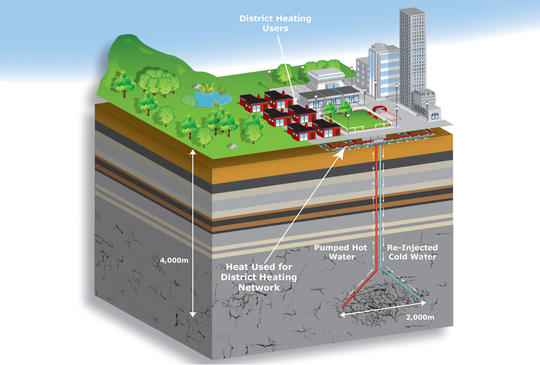
Geothermal renewable energy plan for Ardwick
The holes, located at a vacant site in Ardwick, will be up to 3,200m deep and will allow the company to gain access to vast supplies of geothermal energy.
This natural, renewable heat is generated at the earth’s core and constantly radiates to the surface through conduction. It can be tapped using a production well that pumps hot water from the underground aquifer or geothermal reservoir to the surface. A heat exchanger then extracts the heat from the water which is then pumped back down into the reservoir.

This ground-breaking ‘closed loop’ system, with the water re-injected into the ground to ensure that acquifiers aren’t depleted, will also make it the first truly sustainable geothermal borehole in the UK.
GT Energy is investing £450,000 in this new phase of the project and aims to start drilling in spring 2015, and generating energy by spring 2016. Once complete the project will be the largest commercial development of geothermal heating in the UK, supplying cheap heat to city centre homes and businesses, and creating over 100 jobs.
Yet passers by will be hard-pressed to know the borehole is even there, as once drilling is complete the only evidence left will be a small brick hut and a single valve in the ground.
Once complete the project will be the largest commercial development of geothermal heating in the UK, supplying cheap heat to city centre homes and businesses, and creating over 100 jobs.
According to GT Energy’s managing director Padraig Hanly, a key reason the company chose Manchester was because it lies over the Cheshire Basin, a substantial geothermal resource which was recently estimated to contain upwards of 14,000MW of thermal potential. However, he also praised “a supportive and visionary council” that had embraced the whole concept of geothermal energy from the start.
“What people should understand is that the development of geothermal energy is a big step in ensuring a stable and secure energy supply for their homes and city,” explains Hanly.
“Geothermal energy will be competitive… from the outset but the real savings will be seen over time. Because the energy is stable, customers will not experience the same degree of price variation and increases that we typically see on an annual basis from the major energy suppliers.”
And there are also major carbon benefits for the city, too. “To put it in context, our plant in Manchester will reduce carbon emissions by approximately 12,000 tonnes per annum,” he continues.
“Our belief is that cities like Manchester could sustain multiple plants. We only have to look at cities like Munich which has approximately eight operating plants and to a certain extent Paris, which has 36 operating geothermal heat systems alone.”
Jonny Sadler, environmental strategy manager at Manchester City Council, agrees and says that Manchester continues to adopt a pioneering approach to heat networks, with as many as 40 potential new sites now identified across the city.
He describes the Ardwick project as: “an exciting development … because it provides some real progress in terms of identifying a low carbon source of heat.
“It also builds on work that has been undertaken by corridor partners (on Oxford Road) over the last few years to start to define a joined up heat network area in that part of the city, covering the two Universities, the hospital and the science park.”
And, he adds, it is also an important step in Manchester’s developing Smart Cities programme which is focused on reshaping much of the city’s sustainable, digital and critical infrastructure.
Contributor Profile
Mark Hillsdon is a freelance writer with a passion for nature and the great outdoors. A regular contributor to magazines such as Coast and CountryFile, he also writes on sustainability for the Guardian, and the occasional travel piece for the Independent. On Sunday. He has also been writing on all things Mancunian since first getting off the Euston train as a student nearly 30 years ago.

